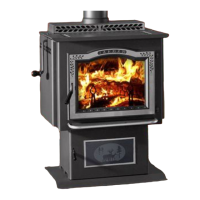Begin with the bypass damper open, and the air
control lever at the maximum setting, all the way
to the right. Be sure the ash pan door is closed
and latched.
Start with a bed of crumpled paper and kindling
sized about finger width; place several 1" - 2"
(25mm - 50mm) split pieces of dry wood on top of the
kindling, followed by a few 2" - 3" (50 mm - 80 mm)
split pieces. Lay the wood in a crossed pattern to
allow maximum air ow. Ignite the paper and close
the loading door(s). Allow this start-up re to burn
for a few minutes, keeping the bypass damper
open. Add about ve more pieces of wood in the
2 to 3 inch (50 - 80mm) size range, making sure
that the fuel bed is all the way across the rebox
and staggered to allow airow. Close the door and
allow this loading to burn a few minutes.
Add increasingly larger pieces of wood to the
re until you have a thick bed of hot embers,
approximately 2 to 3 inches deep at the back of
the grate and at least an inch deep at the front.
Providing you have the charcoal bed described
above, close the bypass damper by pulling the
handle toward the front of the stove. This will begin
the highly efcient mode of operation where the
exhaust gases get re-burned in the secondary
combustion package. If you cannot achieve a
charcoal bed within the rst 15 to 20 minutes, your
wood is likely too wet, and you may need to burn
the re longer and/or hotter to compensate for the
extra energy needed to drive out the moisture.
If, after ve minutes of burning with the damper
closed, smoke is visible coming from the chimney,
you probably do not have the proper coal bed.
Open the bypass damper and continue with the
process until a signicant coal bed is formed.
To regulate the speed of the optional convection
blower, adjust the variable speed control from low
to high by turning the knob located on the blower.
The blower speed should be matched to the air
control lever setting. When the air setting is low,
the blower should always be at the minimum set-
ting. At high settings, above the rst notch on the
air control, the blower may be set to your desired
control level. Be sure the blower cord does not run
under, over, or in front of the stove.
The air control lever is located directly below the
ash lip of the stove. Using this lever will enable
you to vary the amount of air delivered to the re,
creating a range of heat outputs. The low heat
output setting is to the left, and high is to the far
right. Do not, under any circumstances, alter the
conguration or operation of the air control lever.
For low burn, slide the air control to the leftmost
notch. For medium burns, use notches 2 or 3.
Maximum heat is attained with the air control all
the way to the right.
If your wood is not seasoned long enough or
is high in moisture, you may have to adjust the
primary air 1 or 2 notches higher to sustain a low
burn rate with the cleanest possible exhaust.
Never use gasoline, gasoline-type lantern
fuel, kerosene, charcoal lighter uid, or similar
liquids to start or “freshen up” a re in this
heater. Keep all such liquids well away from
the heater while it is in use.

